Faculty strike averted. Now what?
ADSHAYAH SATHIASEELAN NEWS EDITOR

The University of Western Ontario Faculty Association reached a tentative agreement with Western at 10:23 p.m. on Nov. 14, averting a strike that was set for 11:59 p.m. that night.
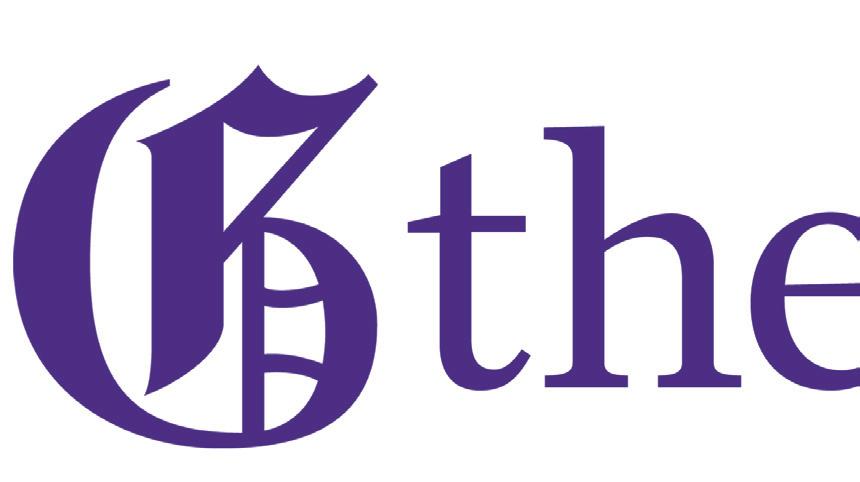
The strike would have shut down most classes across main campus, though the tentative deal meant all activities continued as scheduled Nov. 15.
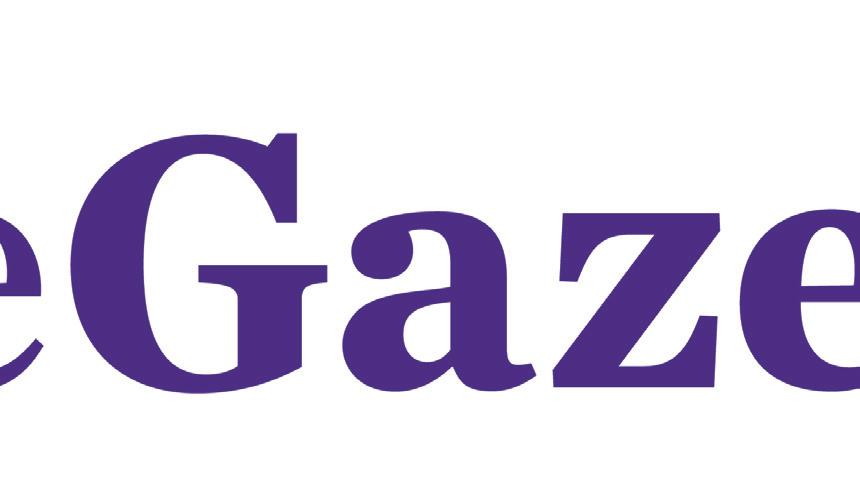

The terms of the agreement will not be disclosed publicly until both UWOFA and Western University’s Board of Governors have viewed the tentative deal and voted to ratify it.

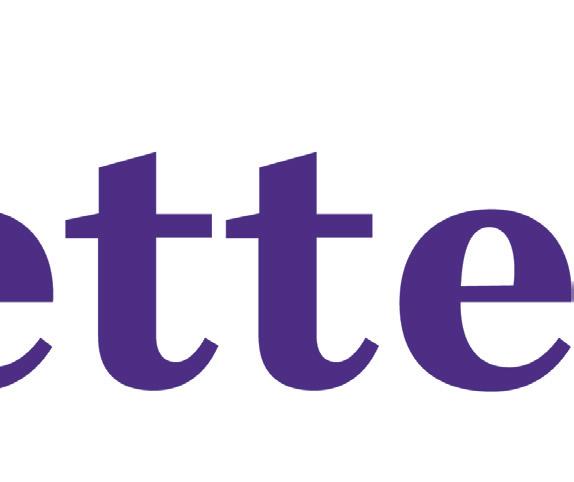
UWOFA had not scheduled a date for ratification voting by the morning of Nov. 15.
Western’s Board of Governors is set to meet Nov. 17, though ratifying the agreement was not on the agenda at time of publication. The board’s next scheduled meeting is not until Feb. 2, 2023.
Western said in a statement after reaching the tentative deal that the parties “will soon vote on whether to ratify the agreement.”
The next step in the negotiation process for the union will be presenting the tentative contract to its Board of Directors.
In 2018, the UWOFA Board of Directors recommended the tentative agreement be brought to the full membership for ratification a week after the tentative deal was reached. An overview of the tentative agreement was provided at a faculty Bargaining Unit meeting before the ratification vote, and
members could also review the details of the agreement by signing into the private members’ area of the UWOFA website with their Western credentials.
The agreement was ratified by 90 per cent of UWOFA members during in-person and electronic voting on Nov. 22 and Nov. 23, 2018, two weeks after the tentative agreement was reached.
Western’s Board of Governors ratified the new four-year collective agreement with UWOFA on Nov. 29, 2018, which included a salary scale increase of 1.5 per cent in each of the first three years of the agreement, and 1.75 per cent in the remaining fourth year.
Western football plows Queen’s, remains OUA kings
RYAN GOODISON SPORTS EDITOR MILES BOLTON SPORTS EDITOR
Western defeated Queen’s in the 114th Yates Cup 44–16, winning the OUA football championship for the second consecutive year.
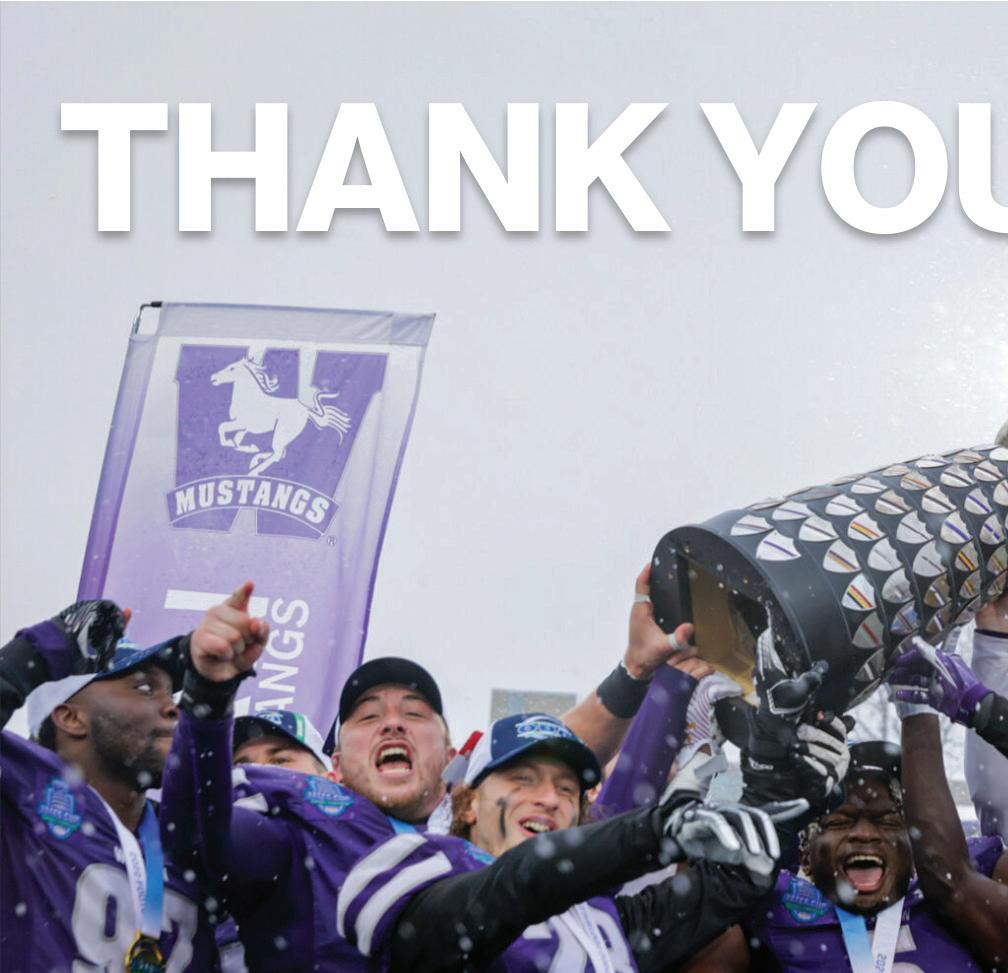

“I’m so proud of our players, our coaches and our sta . This was a total team victory,” said Mustangs head coach Greg Marshall.
Western University battled the Queen’s University Golden Gaels in mistake and snow-heavy football. The Mustangs had multiple wild snaps throughout the first half, giving up a field-goal opportunity.
Haylor-Semotiuk Field at Western Alumni Stadium was covered in snow Saturday afternoon, making it dicult for running backs and receivers to find much traction throughout the game.
“You expect this in Canada, [it's the] Yates Cup [in the] middle of November,” said Mustangs defensive coordinator Paul Gleason. “We're used to this, we're built for this, and [the team is] too. [What matters is] whoever is going to be able to run the ball [and] whoever is gonna be able to stop the ball. It's typical Canadian playo weather."
But Western fought through. The team came up with massive plays and held the lead going into the half.
Mustangs’ quarterback Evan Hillock had a huge 57yard pass to receiver Savaughn Magnaye-Jones for the game's first touchdown. But the team made a mistake on the point-after attempt with another wild snap, leaving the game at 6–0.
Western running back Keon Edwards made it through the Queen’s defensive line with a huge 81-yard run, taking it all the way to the Gaels' 10-yard line. Hillock faked a pass with an empty hand during the play to draw the secondary o of Edwards. Running back Keanu Yazbeck finished o the drive with a 10-yard touchdown.
Edwards ran for 173 yards in the first half alone — and the Queen’s defence couldn’t stop him.
“[Edwards] is an every-game player. What you see is what you get. You get consistency, e ort and he runs hard,” said Marshall.

Second-string running back Edouard Wanadi didn’t play in the Yates Cup due to personal family matters, according to Marshall.
But having only one half of the Mustangs' two-headed purple monster didn’t hurt Western’s run game.
NOVEMBER 17, 2022 VOLUME 116 ISSUE 4 since
SPORTS NEWS Wampum Learning Lodge opens as new home for Western’s Indigenous initiatives Beyond box scores: What’s working, failing so far in Mustangs basketball season P3 Campus co ee sucks P4 CULTURE Lara Buchar: From Western MIT to the Food Network P5 OPINION
1906
P7
CONTINUED ON P7
SOPHIE BOUQUILLON GAZETTE
The Mustangs football team lifts the Yates Cup for a second season in a row, Nov. 12, 2022.
CONTINUED ON P2
What's next for faculty union and Western?

CONTINUED FROM P1
Western’s faculty collective agreements usually last four years, but this year, the faculty union bargained for a shortened three-year-long collective agreement. The aim was to “carry [faculty] through the Bill 124 period that restricts salary increases,” according to an email from UWOFA Faculty of Information and Media Studies representative Amanda Grzyb to members last Saturday.
Bill 124 put a one per cent cap on compensation and benefits increases for Ontario public sector workers, including university faculty, for a threeyear period ending Dec. 31, 2024.

Grzyb’s email said the university still wanted “a 4-year deal, but they are o ering a very low salary increase (2.25%) in the 4th year.” UWOFA’s website said the university has also o ered an additional “small one-time only lump sum for Full-Time Members” in the fourth year.

It is unclear if the current tentative agreement has a three- or four-year limit. If the union was successful in its proposal for a three-year deal, it would return to the bargaining table with Western in 2025.
UWOFA and Western began this year’s round of negotiations on April 7 when the union gave the university o cial notice to bargain. Both sides have hired a conciliator to help with the process.

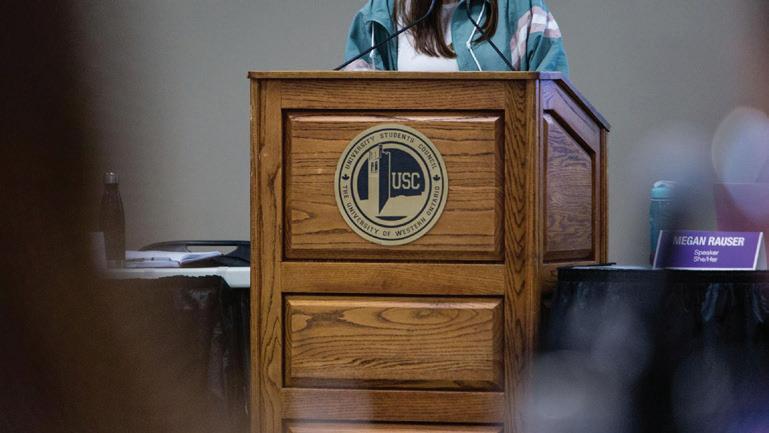
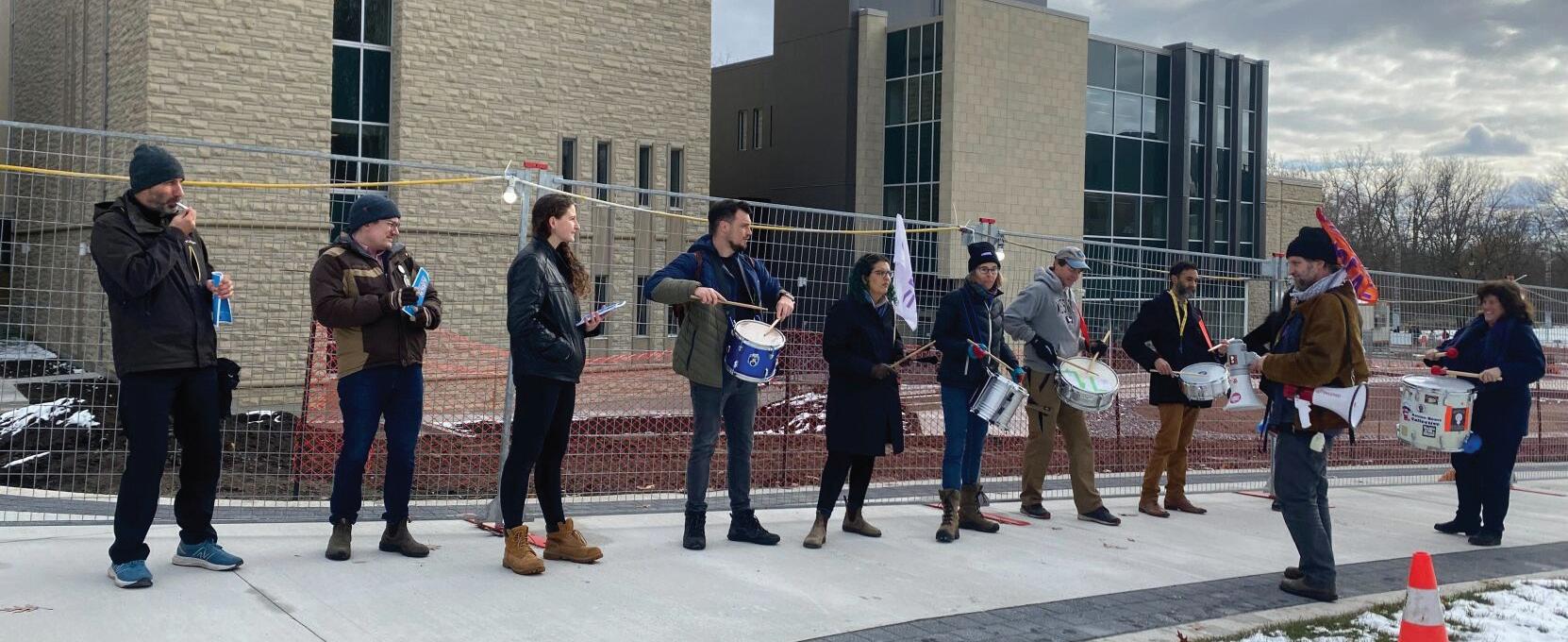
UWOFA called for a strike vote on Sept. 20 and 91 per cent of members voted in favour of going on strike “if necessary.”
In the days leading up to the tentative deal, UWOFA prepared for a strike, setting up porta-potties for picketing at campus entrances, moving to a new o -campus strike headquarters and training “picket captains.” The faculty union was seen handing out leaflets near the Natural Science Centre bus stop and protesting on campus accompanied by their drumming band, the UWOFA Collective Beats.
The vote to strike “if necessary” came shortly after UWOFA released a bargaining report, “Every Budget is a Choice 3.0,” claiming Western built up a record-setting surplus of $1.1 billion over the last 12 years, with a $231.4 million surplus in the first year
of the pandemic alone. The faculty union argued Western “generates more money than it spends,” but has yet to reinvest in faculty members.
According to UWOFAs most recent public bargaining updates, as of Nov. 10, Western had opposed the union’s asks for reducing workload by hiring more faculty, converting contract faculty to full-time positions to give them more job security and giving part-time faculty health benefits — it is unclear what agreements were reached on these fronts in the tentative deal.
UWOFA said it progressed on several items prior to the tentative agreement Nov. 14, including reducing the frequency of performance evaluations from annually to every three years, creating a joint working group to make recommendations to improve the working conditions of members with

disabilities and setting a clear timeline for investigations potentially leading to discipline of a faculty member.
Western did not comment publicly on the details of the labour negotiations.
The Nov. 14 tentative agreement is the earliest a Western faculty strike has been called o in recent years. Four years ago, Western faculty almost went on strike when negotiations stalled. UWOFA called for the strike to start Nov. 9, 2018, but reached a deal with the university at 2 a.m. that morning.
In 2010, the parties continued beyond the 12:01 a.m. strike deadline on Nov. 3, 2010 and reached a tentative deal at 3:40 a.m..
In 2014, UWOFA reached a tentative agreement with Western before filing a “no board” report or setting a strike deadline.

Council’s Western Lifeline discussion cut short; USC pres suggests ‘legal advice’
ADSHAYAH SATHIASEELAN NEWS EDITOR
Adiscussion about the relationship between the USC and its ratified pro-life club, Western Lifeline, was cut short at the Nov. 9 council meeting after USC president Ethan Gardner suggested council “obtain legal advice” before continuing talks about the club.
Huron University College councillor Siddharth Maheshwari brought forward a “for discussion” item related to Western Lifeline saying they’d received “many complaints through multiple platforms about the status of the club.”
Maheshwari clarified this was not a motion to de-ratify the club, unsure if this was something the council could do, but rather a topic “students need to see us talking about … addressing their concerns.”
“I don’t think we’re going to get away with trying to shirk from this discourse,” said Maheshwari, highlighting both an opinion column and a letter previously published in the Gazette on the topic.
Maheshwari said they felt the column, which pushed for the de-ratification of Western Lifeline, had “many salient points, the first being that the University of Ottawa, Carleton University and the University of British Columbia have previously de-ratified pro-life clubs.”


They ended by asking the University Students’ Council executive what options were available to council regarding the club.
In response, Gardner said if the discussion about



The USC podium, Oct. 30, 2019.
Western Lifeline “does go to a conversation, I would ask that we obtain legal advice before having this conversation to make sure that all councillors understand the potential ramifications of saying certain things on the council floor that could be published.”

“I would hate to see any councillor be put in a position where they are, not accused, but … super slandered,” Gardner added. “There's been several instances of this in North America, where certain clubs or certain groups have elected to do this. It doesn't matter if the [law]suit is valid or not. It's the process.”
Gardner further explained a club’s de-ratification is not in council jurisdiction, but rather in the Clubs Governance Board’s hands. The CGB acts as a designated council to create, enforce and amend all USC bylaws, policies and procedures related to clubs.
Gardner told council he would “be more than
happy to share” the portal for reporting clubs that have violated policies.
In a statement to the Gazette after the meeting, Western Lifeline’s executive team said they “have remained a USC-ratified club for over a decade. We abide by all rules and regulations set out by the USC, and we expect that the USC will treat us fairly.”
“While some students may not approve of us because we hold pro-life beliefs, this does not mean we are not in compliance with USC regulations and is not grounds for club de-ratification,” the club’s executive team added. “Ratification is not a popularity contest, nor is it an endorsement of our views, and the USC has a duty to apply its policies fairly and without discrimination.”
No further discussion occurred at the meeting, but Maheshwari told the Gazette they planned to “consult with the executive, councillors and students before suggesting any course of action” and is “looking to follow up on the legal advice bit president Gardner mentioned.”
Maheshwari believes the earliest discussion would be in January, as council does not meet in December due to exams and the standing committee meetings for the next meeting have already taken place.
Keemia Abbaszadeh, vice-president communications confirmed “if council indicates that they would be interested in furthering this discussion, that's when we would consider seeking legal counsel.”
VOLUME 116 , ISSU E 4 NOVEMBER 17 , 2022 University Community Centre Rm. 263 Western University London, ON, CANADA N6A 3K7 Editorial editor@westerngazette.ca EDITOR-IN-CHIEF HOPE MAHOOD DEPUTY EDITOR ALEX M C COMB MANAGING EDITOR SARAH WALLACE COORDINATING EDITOR (VIDEO AND FEATURES) LUCAS ARENDER COORDINATING EDITOR (CULTURE AND SPORTS) BIANCA COLLIA ART DIRECTOR CASSANDRA KACZMARSKI NEWS ANDY YANG ESTELLA REN ADSHAYAH SATHIASEELAN SONIA PERSAUD CULTURE LAUREN MEDEIROS CAT TANG DANIELLE PAUL SPORTS MILES BOLTON KIERAN DROVER RYAN GOODISON OPINIONS JORDAN BLOOM HANNAH ALPER COPY ELIZABETH HART SCOTT YUN HO GRAPHICS REBECCA STREEF KAT HERINE G UO ERIN GRACE PHOTO SOPHIE BOUQUILLON VIDEO REBECCA BARTKIW MADELEINE MCCOLL ROMANO WATT MINA AHMAD SOCIAL MEDIA ELIZABETH HART PE’ER KRUT All articles, letters, photographs, graphics, illustrations and cartoons published in the Gazette, both in the newspaper and online versions, are the property of
. By
material
Gazette
you
hard
online archives. @UWOGAZETTE @WESTERNGAZETTE / WESTERNGAZETTE /UWOGAZETTE / WESTERNGAZETTE Send us an email at managing@westerngazette.ca THIS COULD BE YOU! Western University’s o cial student newspaper since 1906 WESTERNGAZETTE.CA @UWOGAZETTE
SUPPORT MANAGER DAN BROWN GAZETTE CON TRIB UTORS MAREK BROOKING EMILY CAO JESSICA COUNTI SAANVI KAPOOR JESSICA KIM MAYA LOUBANI VERONICA MACLEAN
the Gazette
submitting any such
to the
for publication,
grant to the Gazette a non-exclusive, world-wide, royalty-free, irrevocable license to publish such material in perpetuity in any media, including but not limited to, the Gazette’s
copy and
EDITORIAL
QARRI VARUN REDDY
SCHIEFLER CAMILLE SEYRAT OM SHOUNBHAG JOUZIAN WAHHAB
ARISIA
SOPHIA
MARTIN ALLEN GAZETTE
JESSICA KIM GAZETTE Professor David Heap (second from right) leads group of UWOFA protestors, Nov. 14, 2022.
NEWS | P2
SOPHIE BOUQUILLON GAZETTE UWOFA drummer outside strike headquarters, Nov. 11, 2022. SOPHIE BOUQUILLON GAZETTE UWOFA distributes flyers outside of Nat Sci, Nov. 9, 2022.
Wampum Learning Lodge opens as new home for Western’s Indigenous initiatives
LAUREN MEDEIROS CULTURE EDITOR
Western’s Indigenous Learning Space o cially opened its doors to students, sta , faculty and the London, Ont. community this month.
The o cial name for the space is the Wampum Learning Lodge, chosen under the guidance of a Council of Elders and revealed at a naming ceremony Nov. 7. “Wampum” is a term from the Narragansett language meaning “white string of shell beads,” used to record history, create agreements and treaties, tell stories and mark notable events.
Christy Bressette, the inaugural vice-provost and Western University’s associate vice-president for Indigenous initiatives, says the opening of the centre has been a long-time coming.
“There's been a vision in our communities for this centre for this type of collaboration and reconciliation, going back a long, long way,” she says. “We're very excited.”
The call for an Indigenous Learning Space was originally proposed in the university’s 2016 Indigenous Strategic Plan, followed by consultations with students and Elders.
Bressette emphasizes how significant it is to have a space where Indigenous students are celebrated, empowered and cared for, considering the limited Indigenous faculty and curriculum that existed when she was a student at Western in the 1990s.
“For Western, this is really the most overt signal yet to date that shows they are all about reconciliation,” Bressette says.
The centre’s main level with a prominent rounded dome roof — formerly the Faculty of Education library — consists of a gathering space that can fit up to 200 people. The main level also has sta offices, bookable classroom spaces and a community kitchen.

The dome opens up to the third floor with small tables around its perimeter, functioning as a quieter study and reflection space. The lower level holds more classrooms and a media lab, along with a wellness space featuring a waterfall wall piece and a ventilated seating area for smudging.
The centre was designed by Wanda Dalla Costa of Saddle Lake First Nation, the first female Indigenous architect in Canada. Tierra Miller, an American Indigenous architect who worked alongside
Western returns letterbook to Indigenous community
MAREK BROOKING NEWS INTERN
Western returned a letterbook containing the writings of Indigenous Mohawk leader John Brant to its original community of Six Nations of the Grand River on Aug. 23.
The document had been held by Western Libraries’ Archives and Special Collections since it was purchased from the London Public Libraries for $100 in October 1979.
Western Libraries archivist Leslie Thomas took the lead on returning the letterbook.
“In the most elemental way, [it is] just giving something back that's basically stolen property. So part of it is just doing the right thing,” Thomas said.
Brant was a Six Nations Grand River Reserve superintendent and in 1830 was the first Indigenous person to sit in the legislative assembly of Upper Canada — Ontario’s parliament at the time — as a member.
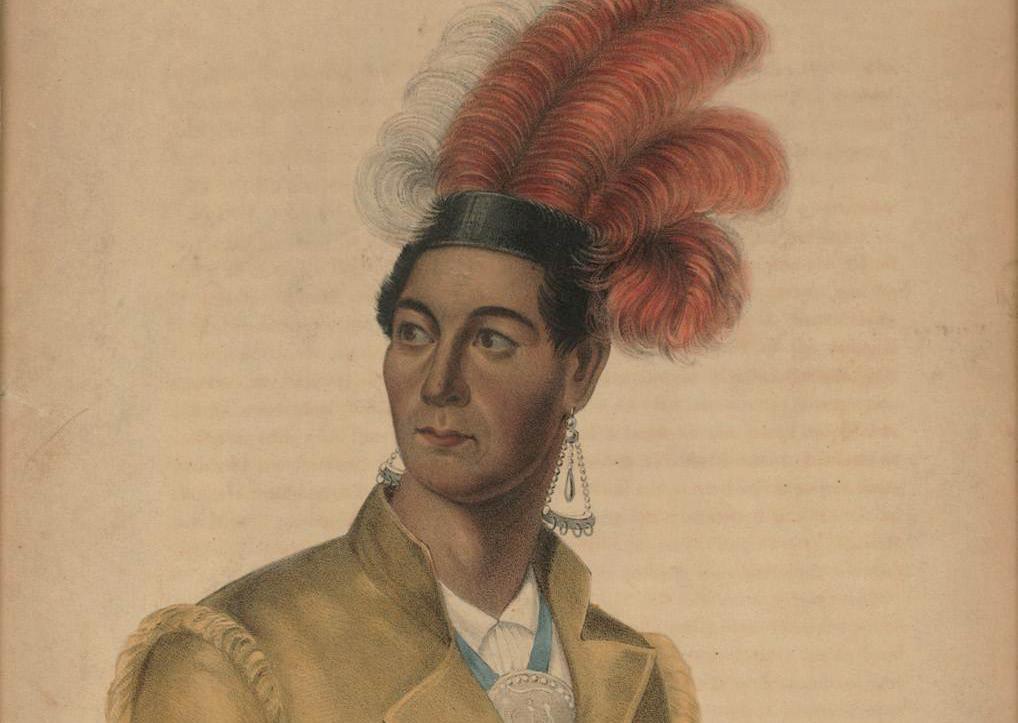
Brant was also involved in the War of 1812, fighting in multiple battles, including the battle of Queenston Heights and the battle of Beaver Dams.
The letterbook was believed to only contain Brant’s personal notes during his time as Grand River Reserve superintendent. But it was recently discovered by a Western Libraries intern that the document also contained the Indigenous Band’s government a airs records, such as various meeting notes between Brant and Indigenous Band members, according to Thomas.
“[The letterbook] was important because it had records of council. It's everything to do with things that were going on during that time period related
to Indigenous people in that area,” said Thomas.
The Truth and Reconciliation Commission’s 70th call to action states the archivists, with the help of Indigenous partners, need to review and comply with the United Nations declaration on the rights of Indigenous peoples when dealing with Indigenous documents or artifacts.
“This is something that archives are working on quite a lot, and have been for the last while in terms of looking at what we have, and whether we should [return it] to who it properly belongs to, if possible,” Thomas said.
Brant died of cholera in 1832 at 37 years old, though his legacy still lives on in the letterbook that has now been returned to its community.
Western Libraries asked for permission from the Grand River Six Nations to digitize the documents which can be found on their website.
Dalla Costa, says the design takes inspiration from the natural world.

Design elements include a moss wall, hung White Oak “cookie slices” gifted from Facilities Management at Western, glasswork that draws in light into the main dome of the building, a medicine garden and an outdoor ceremonial space sheltered by an arbour, inspired by a traditional Haudenosaunee lacrosse stick basket.
Paula Hedgepeth, the community relations and
space coordinator at Indigenous initiatives, says the design promotes serenity and the interconnectedness of humans and the natural world — specifically the blue and rusted earth green colours of the walls and furniture. All four elements of water, earth, fire and air are reflected in a space in the centre.
Hedgepeth also highlighted local Indigenous artists featured in the design. Artwork spans every floor of the centre, telling stories of Indigenous peoples in the area. The centre hopes to expand their collection in the coming years.
“Storytelling and art go hand-in-hand,” she says. “When you’re looking at a piece of art, you’re looking at a part of our history, culture [and] creation stories. Having those local artists reflected in our space tells a lot about who we are as a community, as a people and as three distinct nations.”
According to Bressette, every part of the centre is intentional and steeped in symbolism. She hopes the centre will bring the earth and sustainability, Indigenous ways of knowing and being, to all faculties at the university.
“I’m hoping the work we’re doing here can be a model for other institutions,” Hedgepeth adds. “We’re doing what we can to help our communities with cultural reclamation and language revitalization — all those di erent things that we’ve lost.”
The Indigenous Learning Space can be booked by anyone in the London community to host events relevant to Indigenous communities or that have Indigenous themes. Academic gatherings relevant to the wider community can also be hosted in the space.
The Indigenous Learning Space will serve as the central hub of Universities Canada’s Building Reconciliation Forum in June 2023, a national threeday event that will bring together academics to discuss reconciliation in Canadian universities.
Holocaust survivor Fishel Goldig speaks on the importance of education
 MAYA LOUBANI CULTURE INTERN
MAYA LOUBANI CULTURE INTERN
Holocaust survivor Fishel Goldig told his life’s story at Western’s Survivor Testimony event Nov. 10 over Zoom.
Katie Goldig, the director of Western Hillel organized the event with the University Students’ Council and and Western University’s O ce of Equity, Diversity and Inclusion as part of a series for Holocaust Education Week.
Katie is also Fishel Goldig’s granddaughter, and she expressed her admiration for her grandfather’s strength.
“I am so proud to be his granddaughter,” she said. “Even though it must be di cult for him to relive [the stories of the Holocaust], he chooses to tell his powerful story every day.”
Born in 1933, Goldig spent his childhood in Mielnica, Ukraine. He was only six years old when he first experienced antisemitism on the walk home from school, where his classmates would harass and taunt him for being Jewish.
Goldig and his family were forcibly removed from their home and transferred to the Borszczow ghetto soon after. He remembers feeling fear while in the area, as it was enclosed in barbed wire and plagued with disease, rodents and hunger.
“Life in the ghetto was inhumane,” said Goldig.
1836.
OF ONTARIO
After escaping the ghetto and spending months in the forest, Goldig and his family spent two years hidden in an underground cave. They were only allowed to leave for short periods at nighttime.
Nikolay Krauchuk, a Ukrainian farmer, helped
hide the Goldig family. Krauchuk brought food, water and supplies to them daily, as well as removed their waste.
“For me, [Krauchuk] wasn’t just a farmer — he was an angel sent from heaven,” said Goldig.
Goldig and his family were liberated in 1944. They returned to their old house and town, eventually immigrating to Canada in 1948, where they landed in Montreal and have lived since.
Goldig explained that, no matter where he was in his life, he was always practicing and working on his Jewish faith and studies in order to stay positive in his family’s situation.
“We kept our religion, culture and customs as much as possible … this is how we kept our hope,” he says.
Goldig’s granddaughter expressed the importance of hearing direct testimonies from survivors like her grandfather to keep their memory and stories alive. “Our days of hearing from survivors are limited as they grow older, and it will become our responsibility to continue telling these stories in the years to come,” she said.
The event ended with a Q-and-A portion, with questions from Zoom attendees. Here, Goldig reiterated the importance of education, love and kindness in a world that can turn to hatred so quickly.
“We must confront hate and all live together,” Goldig said. “[Future generations] must take over and tackle the fight I fought all my life.”
NEWS | P3
COURTESY OF ARCHIVES
Portrait of John Brant, Chief of the Six Nations by Charles Bird King
SOPHIE BOUQUILLON GAZETTE Grand opening of the Indigenous Learning Centre, Nov. 7, 2022.
Opinion: Students need to talk about antisemitism
HANNAH ALPER OPINIONS EDITOR


Iam proud to be Jewish — always. Though I am not religious, for me, being Jewish is spending time with family, doing good in my community, being kind and compassionate towards others and tikkun olam (meaning “to repair the world”).
But, feeling proud to be Jewish does not always mean I feel safe being Jewish, and this feeling has particularly flared up in the last few years. This is because I have become politically aware as I get older but also, antisemitism has just gotten worse. And after Holocaust Education Week, students need to care about the problem and talk about it.
I have found, as a Jewish student, a lot of people try to tell me what is and what is not antisemitism. I rarely see non-Jews standing against antisemitism online or in real life because frankly, many don’t really believe antisemitism exists. But record levels of antisemitism were recorded in Canada in 2021, according to a B’nai Brith Canada report.
Many forget the Holocaust only happened just over 75 years ago, and Holocaust education is sadly dwindling. If we forget or are not educated on
 BOUQUILLON GAZETTE
BOUQUILLON GAZETTE
Inside the ShadowLight Cattle Car, Nov. 7, 2022.
the atrocities of the Holocaust and the deaths of six million Jewish people — and five million others — we will be doomed to repeat the past.

We are lucky to be able to hear directly from Holocaust survivors themselves who are brave enough to speak on their experiences in the hopes of inspiring future generations, but they, unfortunately, won’t be here forever.
It seems unbelievable that anything like the Holocaust would ever happen again and, as an activist and optimist, I would definitely like to believe our world has become more caring and progressive. But we have seen recently how online hate and antisemitic comments can manifest and lead to in-person bigotry and hate crimes. Hateful words turn to hateful actions.
Opinion: Campus co ee sucks
LAUREN MEDEIROS CULTURE EDITOR


In a university campus full of co ee options, I am left su ciently ca einated, yet disappointed.
I wouldn’t label myself a “co ee snob,” but I do have some standards when it comes to getting my morning cup — both for the co ee itself and the place I get it from.
Being someone who spends what feels like all of their waking, or at least productive, hours at the University Community Centre, maintaining a steady buzz of ca eine is di cult.
As soon as I take the last sip of the mediocre Keurig-made co ee I bring each morning from home, I’m on a mission. My mind is thinking about logistics: if I only have 15 minutes, which line will move the fastest? Is walking five minutes to Lucy’s at Somerville House worth it to get a couple shots of mediocre espresso from the self-service machine?
Craving ca eine is my form of being “hangry.” Getting another cup seems like a life or death situation — suddenly nothing else matters but getting that perfect bitter taste on my tongue once again.
Given the all-encompassing, intense hold that co ee has on me, you might begin to understand why, after nearly three and a half years of being on campus and surveying my options, I am unsatisfied.
This might seem like a ridiculous statement, considering there are plenty of places under the same roof, but Tim Hortons is always running out of milk alternatives and Tims Express seems to be closed half of the time. Starbucks is two dollars too expensive and co ee from The Spoke is either burnt and unbelievably sour or tasteless and
watery — there’s no in between. When I walk by all the eager first-years in the hour-long line up, I have to stop myself from whispering, “it’s not worth it.”
In addition to the UCC locations, there are 11 eateries to get self-serve co ee, along with five randomly placed vending machines. And when I say random, I mean random. There’s one hiding in the basement of University College tucked away in a corner, almost like it's asking not to be used.
The thing is, when I go to get a co ee, half of it is about the experience. When I’m clicking a button to release unimpressive bean juice, I long for the face-to-face interaction with a barista, asking them what they recommend.
There are three larger “cafes” on campus that have higher-end espresso machines and more specialty drinks — DaVinci’s in the Spencer Engineering Building, Chambers in the Law Building and Einstein's in Natural Science Centre. All three attempt to di erentiate themselves from one another, but the creative vision and ambience is not fully fleshed out.
DaVinci’s calls itself a “renaissance cafe” on its sign, but looks no di erent than a residence cafeteria — certainly no ode to classical architecture.
When I was trying to find Chambers for the first time, I got lost in the building for 20 minutes before realizing it was tucked away in the basement and other than the sta members, there was nobody there.
Waiting in line at Einstein’s is immediately stressful with all of the students rushing in and out of the entrance to Allyn & Betty Taylor Library across the room. The cafe feels like it was copy-and-pasted into a pre-existing campus environment.
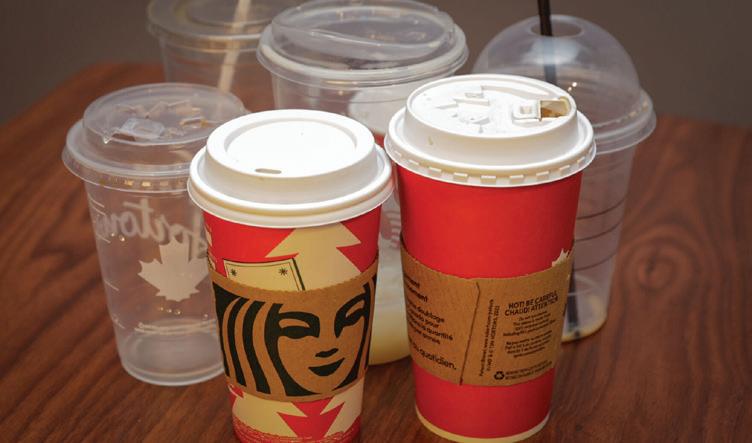
Einstein’s does o er a couple of seasonal beverages that the other two do not, like the dirty chai latte, but for the most part, they all have the exact same drink menu and prepackaged sandwiches. They are more of a grab-and-go service counter than a cafe.
I know I’m being picky and maybe unrealistic in some regard, but let me fantasize here for a moment. Imagine: a newly constructed on-campus cafe, centrally located, with an outdoor entrance and original branding. An aesthetically pleasing, quiet space that provides a brief escape from campus, a perfect place to catch up on work or with a friend.
I think Western can fit this into their budget.
Kanye West perpetuating antisemitic stereotypes and being openly antisemitic led to a hate group hanging banners reading “Kanye is right about the Jews.” Saugeen-Maitland Hall was recently vandalized with unspecified hate symbols and Queen’s University has seen several antisemitic vandalism incidents, particularly at Jewish spaces, in recent weeks.

But in the face of darkness and hate, there is always light. That light is people with influence standing against antisemitism and encouraging others to do the same. Never before have I seen so many non-Jewish people condemning antisemitism and for one of the first times in a few years, I don’t feel alone or isolated as a Jewish person on social media.
Comedian Amy Schumer popularized a graphic reading “I support my Jewish friends and the Jewish people” and was extremely vocal about her stance against Kanye’s comments. NBA legend Kareem Abdul-Jabbar for years has stood with Jewish people and even penned an essay urging people in Hollywood and sports to speak up against antisemitism. My hope is that the momentum continues and wide outrage against antisemitism is not oneo , but becomes the norm.
I feel lucky to feel safe on campus at Western University, and I hope my other Jewish peers feel the same. To mark Holocaust Education Week,
EDITORIAL
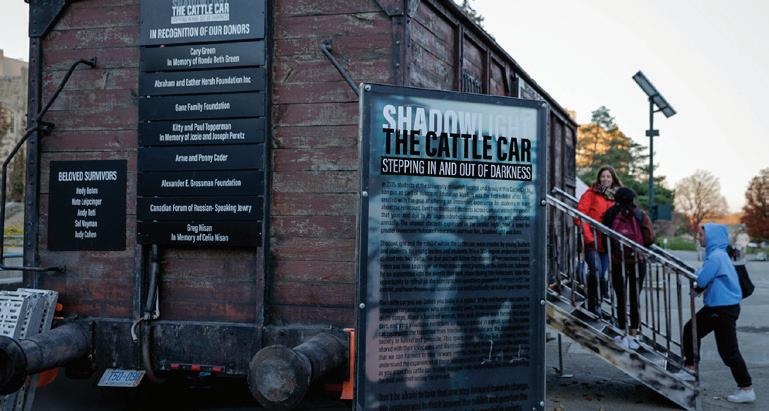
BOUQUILLON GAZETTE
Outside the ShadowLight Cattle Car, Nov. 7, 2022.
Western’s O ce of Equity, Diversity and Inclusion partnered with Western Hillel to bring events on campus to encourage a deeper understanding of the Holocaust and antisemitism.
Now more than ever, we need to remember #NeverAgain. We need to stand together against all forms of hate. Change can start small by saying something if you hear antisemitism in a conversation. We’ve seen what hate unchecked can lead to, and it’s up to each of us, whether you’re Jewish or not, to get educated and stand up.
There’s a Hebrew saying that really comes to mind when thinking about all this. L’dor v’dor. From generation to generation — we are stronger together.
The Ceeps is London’s best nightlife destination
Ina town where student bars and clubs come and go, London’s community staple, The Ceeps, reigns supreme as London's best nightlife destination.
Situated at the heart of Richmond Row, The Ceeps has been operating since 1890. It's not an accident that it’s lasted for such a long time. The history and tradition associated with its age make it a reason to go the first time, but its other highlights are what keep students coming back for more.
Ceeps is huge, with a dance floor and seating area that lets patrons pick how they want to socialize. Perhaps its ability to fit so many people inside is why you seem to know everyone there.
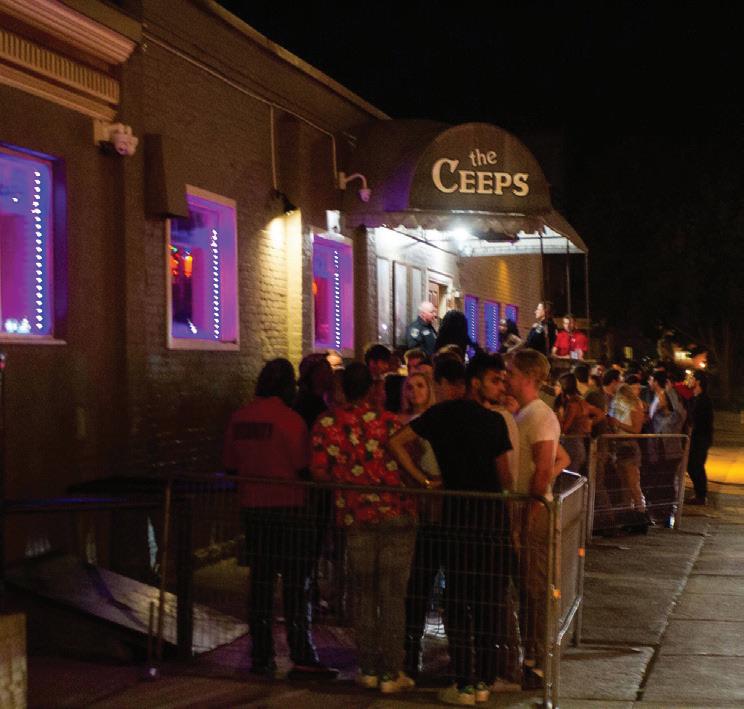
The long line to get in is worth it.

Places that are similarly more "clubs" than "bars," like Belfort and Lost Love, have some of the same perks Ceeps has. But Belfort can leave you waiting at the bar for a drink for quite a while, and at Lost Love pricey bottle service is almost a prerequisite to get in and have a place to sit.
Molly Bloom's, the Gazette's second-rated option for a night out, has an entirely di erent mood. But the vibes are what makes it the best alternative to Ceeps. Good pints, low lights and soft music set the ambiance for a more relaxed night out with friends. It's a bonus if you go for karaoke night.
Half-price wine nights at McCabes or a latenight beer at Warehouse fit the same need, but Molly Bloom's does it better.
The Gazette's third choice, Cowboys, is a niche spot. It'll be your favourite place to go if you love country music. Otherwise, you might be in for a rough night.
Jack's has played its way into students' hearts with two words: Dollar Beers. If you go on Monday or Wednesday nights, it is significantly cheaper to buy alcohol than in other locations.
If you are willing to spend enough time at the bar to buy the tiny cups of cheap beer, you might forget about the sticky floors and strange cast of regulars. But that doesn't mean it’s our top recommendation for a night out.
What's great about London is the variety of options. Maybe Rock 'n' Roll Bingo at Winks is more your style. During hot months, Barney's patio has the advantage of being outdoors. Even the Gateway Casino is a way to scratch your gambling itch.
The options can appear endless if you're planning a night on the town. The best destination depends on your mood.
But when your group chat is popping o asking where to go out, suggesting Ceeps, Molly Bloom's or Cowboys is an excellent place to start.
Editorials are decided by a majority of the editorial board, and are written by a member of the editorial board but are not necessarily the expressed opinion of each editorial board member. All other opinions are strcitly those of the author and do not necessarily reflect the opinions of the Gazette, its editors, or staff. To submit a letter to the editor, send an email to opinions@westerngazette.ca
OPINIONS | P4
SOPHIE
SOPHIE
RYAN RAFTER GAZETTE
Long lines are to be expected on this college-town's bustling main strip, Sept. 29, 2018.
BOUQUILLON GAZETTE Co ee cups from campus cafes, Nov. 7, 2022.
SOPHIE
Cat’s Chronicles: If you’re reading this, it’s too late












 CAT TANG CULTURE EDITOR
CAT TANG CULTURE EDITOR
Whatever you think your most embarrassing dating story is, I promise mine is worse.




















Up until last week, my worst dating story was pretty basic. My date and I were walking in the park, both bundled up in our big winter coats, when he turned to me and said, “my hands are really cold.”

My reply? Asking – earnestly – if he had pockets and suggesting he use them. I then proceeded to tell him, in an attempt to impress, that my hands never got cold because of my great circulation.
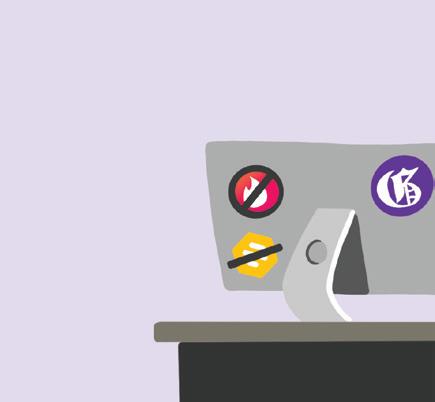
That used to be my most embarrassing dating story — until this past reading week.
While my o cial job title at the Gazette is culture editor, which mostly involves reporting on campus events and local arts, when I swipe on someone new on a dating app, I consider myself a Watergate-level investigative journalist.
If you give me a half an hour, a laptop and a reliable internet connection, I can find a man’s social media accounts, the addresses of the last three girls he’s hooked up with and his ex-girlfriend’s social insurance number — even if all I have to work with is his first name.
I hit it o with a guy on Hinge over reading week, and in my typical Dora the Explorer fashion, I found him on social media and started digging.
What I discovered on his social media feeds concerned me: there were sexy anime girls everywhere. Beautiful, busty anime girls, all in revealing outfits and suggestive poses.






























I took screenshots and sent them to my friend
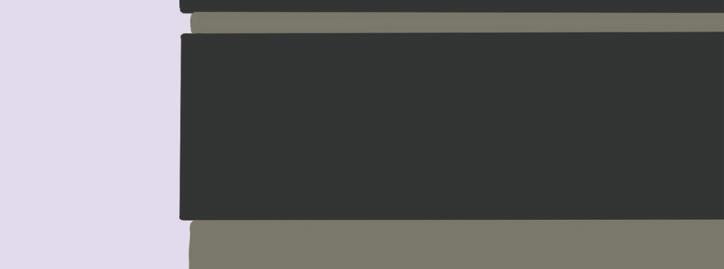
for a second opinion, along with my own commentary. A typical move, except I didn’t send it to my friend — I accidentally texted Anime Boy himself.

The moment I realized I had sent the screenshots to Anime Boy and not my friend, I was horrified. The cherry-on-top was that I sent this string of texts at 2 a.m., after not replying to his previous messages for several hours.
I immediately blocked his number and unmatched him on Hinge. I was fully prepared to change my identity, leave the country and start a new life in Panama — where I could live out the rest of my years in peace and anonymity.
I feel awful about what happened, but I don’t think it’s wrong for me to feel uncomfortable and choose to stop talking to him. What I do feel bad about is that he had to receive that message in such an awkward way.
My friends say it was probably something he needed to hear eventually, and maybe I even helped him reflect on how he presents himself on social media. So, if that’s what I was sent here to do, then I am ready to serve my community.

Opinion: Going easy doesn’t help students long-term
JORDAN BLOOM OPINIONS EDITOR
Professors should have sympathy for students being thrown straight into the fire of in-person university after two and a half years of Zoom education. But translating that sympathy into easier assessments, more lenient deadlines or advantageous testing conditions does not help students.
Since the onset of the COVID-19 pandemic, student assessments largely haven’t been the same. Some school boards, like York Region, had no high school exams for the past two years. Most Western University exams took place online. Some exams have o cially become open book, while others, opting not to use software like Proctortrack to monitor students, are ripe for students to manipulate.
The more lenient the terms of an assessment in any course, the higher grades will be. Students rushing to take a course with easier grades pressures other classes and faculties to match their counterparts’ policies and grades. Then grade inflation follows. No one wins in this vicious cycle.
If you want to know about the dangers of rising grades, ask high school students. The competitive entry average to Ivey Business School is now 93 per cent. The average engineering frosh has a high school average of 88 per cent. This average has steadily risen over the past 20 years, to the point where the average Western admit now has a 91 per cent entrance average.
The margin of error for high school students is slim. On each given assessment they take, it can be hard to impress yourself and improve your odds significantly with a high mark, while the downside of a bad mark can appear to be exceptionally high. The higher grades go, the more stress and pressure will be placed on students to achieve near perfection to reach their goals.
Inflated grades would also come with the risk of damaging Western’s academic reputation, and
thus the value of a Western degree. Instead of competing for undergraduate university admissions like high-schoolers, Western students use their grades to get into sub-specialties, honours specialization programs, graduate programs or jobs after graduation.
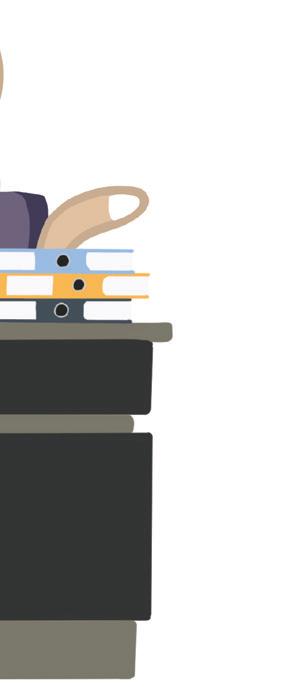
If Western students with high grades get outperformed by students at other schools with lower grades, employers and graduate programs admissions o ces will start to notice and may look pessimistically at future Western applicants.
Once it gets in motion, the only antidote to this cycle is to curve down grades on assessments if the results come back and grades are too high. But that causes damage to the trust students have in the grading process and creates ill will towards faculty, another lose-lose proposition.
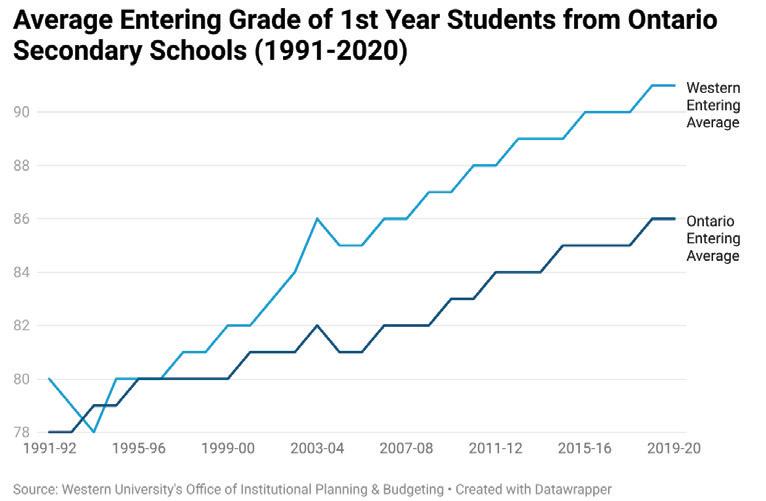
Tougher assessments and harsher deadlines also help students develop soft skills, including time management, dealing with unfamiliar circumstances and handling ambiguity.
Challenging students will almost certainly lead to higher stress levels and all the adverse side effects that come from added pressure.
But stress management is an essential skill that can’t be developed without moderate adversity. If this stress means a student will perform below their expectations — fine. University is a far better place to make mistakes and adapt than whatever lies after it.
Besides, isn’t that part of the learning experience university is supposed to provide?
Lara Buchar: From Western MIT to the Food Network
 LAUREN MEDEIROS CULTURE EDITOR
LAUREN MEDEIROS CULTURE EDITOR
Lara Buchar completed her undergraduate degree certain of two things: she loved to write and she wanted to work behind the scenes in media.

Fast forward seven years, Lara is working as digital editor at Food Network Canada, spending her days editing, assigning pieces and giving feedback to writers, as well as monitoring cultural trends.
She graduated from Western University in 2015 with a degree in media, information and technoculture and a minor in English. Before the Food Network, the editor worked as a marketing coordinator for the Toronto Star’s fashion and beauty section, “The Kit.”
Lara realized she enjoyed the editorial writing side of her job at the Star and decided she needed a creative outlet. With her interest in cooking growing, she began a personal food blog.
Her editors at the time took notice of her blog, which led to her transitioning to The Kit’s editorial team full-time and pursuing a food series called “What’s Cooking,” where she profiled Canadian women in the food scene. The series ran from the beginning of the pandemic until early 2021.
“That series ended up going on to have over 150 profiles, which I’m super proud of,” Lara says. “It was definitely way bigger than I ever thought it would be — a lot of fun and a lot of work.”
As the food series took o , Lara decided she wanted to pursue food writing more seriously.
When she came across the Food Network opportunity online, she jumped on it, having found limited food editor jobs available in Canada. A few rounds of interviews later, Lara landed the job in July 2021.
“It’s so nice to be able to fully focus on food now … it’s what my day revolves around,” she says. “It’s my total dream job.”
Alongside her editing duties at the Food Network, Lara writes her own articles. Sometimes they are “detailed cultural pieces” like interviewing a chef she admires, or something more brief like a food shopping roundup that lists products, which serves as more of a service to readers.

Last month, she was invited to return to campus to speak at the Faculty of Information and Media Studies’ Career Conference — an event she attended when she was an undergrad.
She recalls listening to screenwriter and MIT graduate, Mike Bickerton, who has worked on hit shows Canada’s Drag Race and The Amazing Race Canada. Bickerton returned to this year’s conference as a keynote speaker.

“Being invited to come back [to Western] and speak was huge for me,” Lara says. “To be on the other side, speaking to students, [it felt] Western was recognizing me in that way. It was a total full circle moment.”
The editor looks back at her time at the university fondly and attributes much of her success to class work and overall experience. In her first MIT class, she remembers her professor instructing the class to “go deeper” with their writing — a concept she continues to apply in her everyday life.
“I’ll be watching TV or a movie and I’ll be like ‘I wonder what that professor would think about that,’” Lara says. “The cool thing about my job is that I sometimes get to write an essay about something in pop culture that I care about … it feels so MIT.”
Throughout each stage of Lara’s career, she has learned the importance of trying new things and following her natural inclinations.
“You don't have to know what you're going to do for the rest of your life when you're in fourth year,”
she says. “The only way to figure it out is to get out there and see what you actually enjoyed doing — I wish I had known that when I was a student.”
OPINIONS | P5
KATHERINE GUO GAZETTE
COURTESY OF LARA BUCHAR.
Lara Buchar in her o ce at Food Network Canada.
COURTESY OF LARA BUCHAR. Lara Buchar at the Faculty of Information and Media Studies’ Career Conference, October 2022.
CAMILLE SEYRAT GAZETTE
Meet Western’s newest poster boy: Nathan Bugiardini
 LAUREN MEDEIROS CULTURE EDITOR
LAUREN MEDEIROS CULTURE EDITOR
This time last year, Nathan Bugiardini first saw the face of Western’s original poster boy, Avi Roy, pasted on lamp posts across campus and thought to himself, “I can do that.”
Roy’s posters promoted his hip-hop single “Bad One” and led to him becoming a notable campus figure. Bugiardini, a second-year music and administrative studies student had been making his own music for over a year at that point, and decided to follow Roy’s lead.
Bugiardini walked around Western University’s campus a few days later, putting up posters in high tra c areas with a QR code linking to his song “Next to Me.” Just like Roy, Bugiardini soon had random students texting him, sharing their compliments.
Bugiardini decided to attempt a repeat of the feat this year to promote his newest single “Still Want You.”
“I want people to recognize me and be like ‘oh, that’s the guy that makes that music.’ If I’m able to become well known in London, then boom — I’ll naturally grow from that,” he says.
Bugiardini began writing and recording music two and a half years ago at the beginning of COVID-19 in his student rental bedroom studio.
He found himself having more free time than ever before, allowing him to explore his creativity. He experimented with di erent beats and equipment, teaching himself how to produce music all by himself.
“I watched hours of YouTube videos trying to figure out how to make my music sound good,” Bugiardini says. “I haven’t stopped since.”
The new poster boy finds it di cult to put a label on his music style so early in his career. “Still Want
You” leans on the hip-hop side.
Bugiardini says he’s still in an “experimental” stage of his career, where he’s following his inclinations and taking inspiration from the old jazz, 70s rock and hip-hop he listened to growing up.
But this sudden inspiration often means “throwing [school] to the side” for a couple of days. Some songs take a day, others take six months — either way, Bugiardini doesn’t have a problem focusing solely on music.
The poster boy’s ultimate dream in his undergraduate studies is to perform at the university’s Orientation Week. But for this semester, Bugiardini just hopes to release more music than ever, fully confident in his ability to do so independently from home.
“I’m producing it, mixing it and mastering it,” says Bugiardini. “Nobody else does it for me.”
Why you feel socially ‘o ’ after the pandemic
 SAANVI KAPOOR CULTURE INTERN
SAANVI KAPOOR CULTURE INTERN
The sudden switch to online learning and social distancing in 2020 came with mental health dips for many students. But now that Western’s lecture halls and Richmond Row are packed again, some are surprised to find this “return to normal” is even more of a drain.
Second-year management and organizational studies student Salina Guo relates to not feeling comfortable in a new and busy environment. She remembers feeling especially anxious when she first moved into residence in September 2021.
“I remember feeling very overwhelmed and anxious because it seemed like everyone around me had already known what to say to each other in small talk and what to do,” she says.


Guo is far from alone. The pandemic radically changed how we socialized and a switch back to in-person, even a gradual one, is bound to come with some anxieties.
“It’s not a bad thing to ‘feel o ’ in these social settings,” explains Marnie Wedlake, a Western University professor in the health sciences. “There’s nothing wrong with you. You’re just not fully used to it.”
Wedlake notes that having these feelings of anxiety, or shying away from going out, is natural because of this dramatic shift in socialization.
“Remember that you are simply having a reaction to what is around you. We went through a life-changing event with COVID, it's supposed to change you,” Wedlake says.
Despite the importance of socializing and getting to know peers, it’s also important to remember that it’s okay if it isn’t easy, says Wedlake. First-year BMOS student Aiden McAuley considers himself a social person, but still finds himself drained after
a long day with friends and classmates on campus.
“I enjoy the hustle of campus life but I definitely try to set time aside for myself so that I can stay 100 per cent in school,” explains McAuley.
As a social science soph who runs a YouTube channel oriented towards first-year advice, Guo often has strangers coming to her for small talk on campus even when she’s socially drained. She’s found her own coping methods for when she starts to feel anxious or uncomfortable in social scenarios.
“After I speak to anyone who approaches me all I can think of is if I looked good enough or spoke properly,” she says. “I never really felt this way before COVID but now these feelings are more frequent and it gets me anxious. I’ve learned that sometimes it's okay just to leave … When I first came to Western, it felt wrong doing that, but now I do it because I realize it's the best thing for me.”
Wedlake cautions that students should not feel inferior in these moments.
“We can’t expect ourselves to adapt quickly,” she says. “Life isn’t what it was in 2019 and that is the reality.”
Cafe Hopping: CommonWealth
 LAUREN MEDEIROS CULTURE EDITOR
LAUREN MEDEIROS CULTURE EDITOR
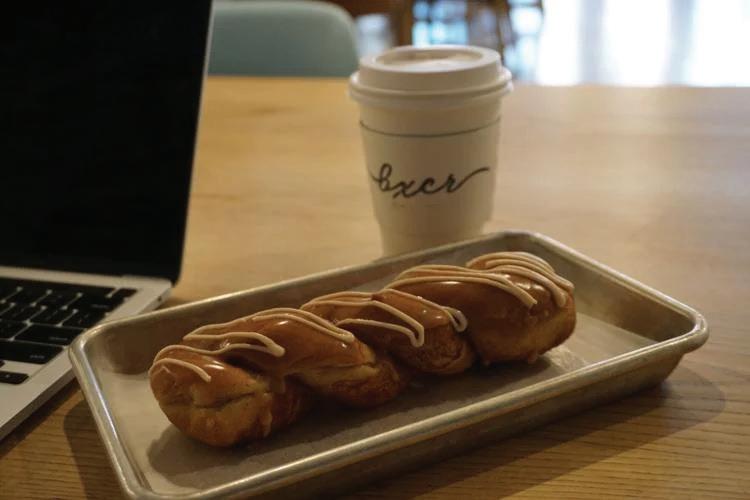

Adonut for breakfast is never a bad idea. That’s what I tell myself as I sit in CommonWealth Co ee Co. early in the morning. CommonWealth is a cafe just past Jack’s on Richmond Street, running alongside its sister business, Boxcar Donuts.
Boxcar o ers hand-cut and hand-decorated artisanal donuts. There’s another Boxcar location at CF Masonville Place, where they bake the donuts, and a third coming soon to St. Thomas, Ont..
I wait outside the door at 9 a.m. for the cafe to open, as I’ve heard from friends that the small batch donuts are quick to sell out. The donut choices are overwhelming — the top row has weekly specials, like peanut butter honey and milk and cookies, and the bottom row are their classic flavours, including apple fritter and chocolate dip.
Along with their standard donuts and weekly specials, CommonWealth releases random flavour drops on their Instagram throughout the week that are only available for 24 hours.
Brittany Sheppard, the manager at both locations, says the cafe always attracts a large crowd in the morning and then again at lunch, when local business people are on their breaks. They try to keep donuts available at all times, but by the afternoon, their stock becomes limited and sometimes have to transport more from Masonville.
I opted for a classic donut — the cinnamon twist — which is a twisted braid and topped with a shiny vanilla cinnamon glaze. I gawk over the other beautiful donuts in the glass casing, like a kid in a candy store, as I wait for my donut and small oat latte — their most popular warm drink.
My order comes to just over $9, which is a reasonable deal considering how good the donut and co ee pairing is. The twist is unbelievably flu y
and tastes exactly like a cinnamon bun.
My only complaint is that my latte is slightly cold, but with the growing line behind me, I know the employees are in a rush. The latte’s espresso has a distinct nutty and fruity undertone, unlike anything I’ve tasted before. At first I was surprised by it, but I enjoy the taste more and more with each sip.
Within 15 minutes, the lineup is out of the door of people ready to pick up their online orders, leaving with boxes full of donuts. Sheppard says there’s an equal amount of business people and students who visit, and even more on weekends.
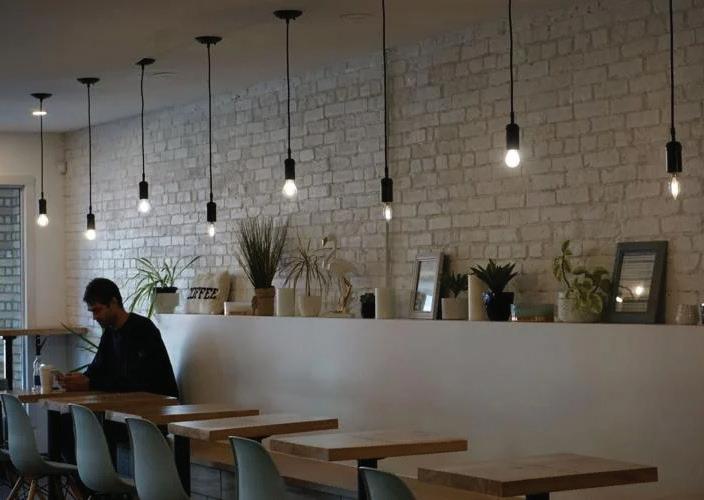
With its hanging pendant lights, white walls and light blue accents, the vibe of the cafe is bright and energizing but also has a calm environment to do work or meet with a friend.
“It's great for us to see people sitting down, wanting to spend their time here and enjoying themselves,” says Sheppard.
I left CommonWealth feeling more uplifted than I usually would on a weekday morning. Maybe it’s just the sugar and ca eine, but I can’t help but feel the friendly service and aesthetically-pleasing atmosphere had more to do with it.
CULTURE | P6
JESSICA COUNTI GAZETTE
COURTESY OF NATHAN BUGIARDINI
LAUREN MEDEIROS GAZETTE
The order counter at CommonWealth.
LAUREN MEDEIROS GAZETTE Boxcar Donuts sign at the entrance.
LAUREN MEDEIROS GAZETTE The cinnamon twist donut and oat latte.
LAUREN MEDEIROS GAZETTE The seating area inside CommonWealth.
Western football plows Queen’s, remains OUA kings
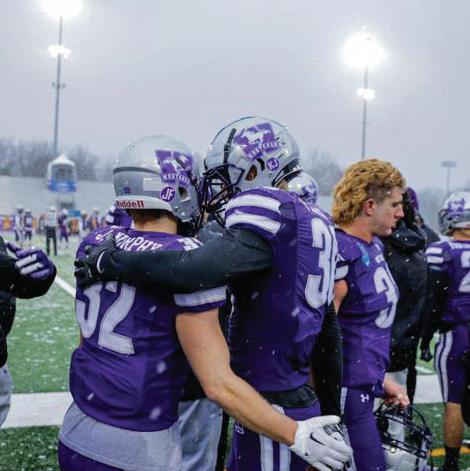
During the play, Justin Nickson fooled the Gaels' secondary by continuing to run his route. Before they found out Robertson had the ball, it was already too late.
Western’s defence came up strong against the struggling Queen’s o ence. With nine minutes left in the game, the Gaels went on a third down to keep their season alive. But defensive end Bruce Maas quickly broke through the Gaels’ o-line and tackled running back Anthony Soles for no gain.
Just over a minute later, Hillock connected with receiver Gri n Campbell for a touchdown to put the game on ice. But bad habits die hard and the Mustangs couldn't stop from scoring one more time. With under five minutes left to play, Edwards scored his first touchdown of the game.
Queen’s tried to put up some points for pride in the final minutes, but hal ack Robert Panabaker intercepted Vreeken to send the Gaels home with their tails between their legs.
When the Yates Cup was presented to Marshall, he declined to lift it first, pointing to Edwards — his star running back and Yates Cup MVP.
CONTINUED FROM P1
“We rushed for over 300 yards and were able to control their run game,” Gleason added. “We gave up no big plays. We stopped the run and we ran it, simple as that.”
Near the end of the first half, Queen’s QB Alex Vreeken ran right up main street and sacrificed his body for the play. The Gaels earned a first down and running back Anthony Soles ran in for a touchdown to put the Gaels on the board.
The game was 13–7 in favour of the Mustangs at half.
But when the second half began, it
was clear that Edwards and the Mustangs would not be denied.
Edwards said he feels like the entire team steps up in these big games — the team works hard to be in moments like this so they don’t disappoint.
Early in the third quarter, the o ensive line made a perfect hole for Yazbeck to run through, and after getting to the sidelines, he brought it in for his second touchdown of the game.
Edwards continued to build upon his impressive first half, putting up 93 yards in the second half and finishing with 269 total yards.
“[Edwards] is the type of player that’s easy to coach, unselfish and always about the team,” said Marshall. “He practices
hard and is a great leader on our team. I’m very proud of him.”

The Gaels had a relatively mistake-free first half but had to face the snow and wind in the third quarter — and the mistakes began to pile up. Queen’s su ered from a wild snap that took them back 25 yards in their first drive of the third quarter.
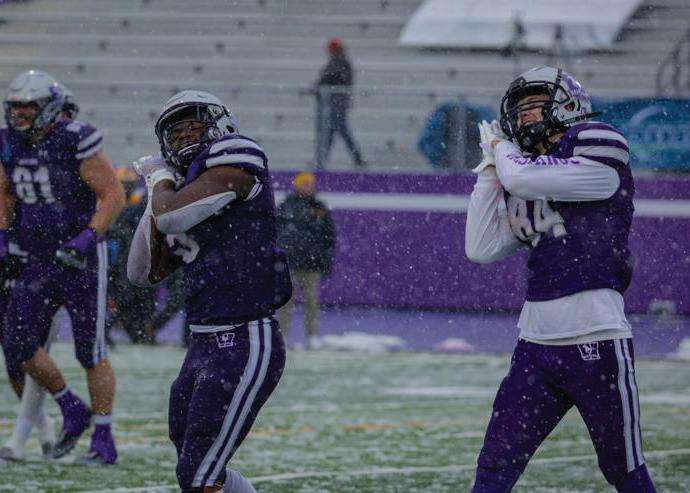
“[We] just [played] hard. We knew we had to do,” said first-year cornerback Jacob Saunders. “We had to stop the run and that's what we did.”
Hillock completed a slant pass to receiver Seth Robertson late in the third quarter. Robertson carried the ball all the way into the endzone for a 73-yard catch and run.
Beyond box scores: What’s working, failing so far in Mustangs basketball season
A data-based analysis of Mustangs sports teams
MILES BOLTON SPORTS EDITOR
The first week of the Mustangs basketball season is in the books and the two squads’ performances couldn’t be more di erent.

While Western University’s women’s squad rode a strong team e ort to a 2–0 start in road games against the University of Windsor Lancers and the Wilfrid Laurier University Golden Hawks, the men’s team struggled to play cohesively, going 0–2 against the same opponents.
An early stats analysis paints a picture of what’s working for the Mustangs so far.
The women’s team has been solid defensively, posting a defensive e ciency of 0.743. Their 70.6 per cent free throw rate is good enough for fifth in Ontario University Athletics, sinking 36 of 51 from the foul line.

The women’s team has also been good at generating secondary scoring chances. Averaging 15.5
o ensive rebounds through the first two games, the Mustangs sit fourth in the OUA.

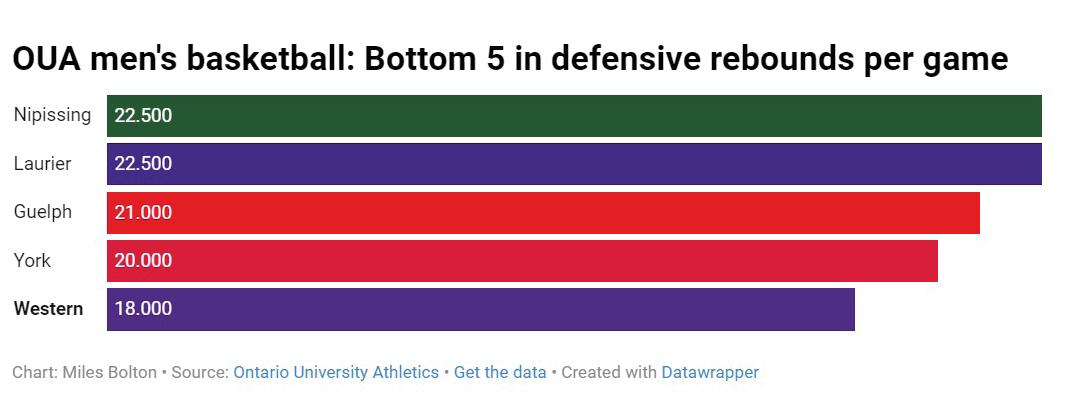
The men’s team’s numbers tell a di erent story. Western’s 18 defensive rebounds per game is last in the conference, and their 29.5 board average is second-last. Poor rebounding by their own net has hurt the Mustangs’ defensive e ciency of 1.090, which is 14th in the OUA.
The men’s team’s 42.8 per cent field goal rate is seventh in the OUA, and second-year forward Matteo Zagar leads the conference with an 87.5 field goal percentage through the first week of action.
As fourth-year guard Jerric Palma said after their second loss of the season, learning to play well as a team is the number one key to success for the men’s team, but it’s clear Western needs to be more responsible around their own basket.
As for the women’s team, they just need to keep doing what’s worked well for them so far. They’ve been solid at both ends of the court and are playing well together.
“It feels good [to win MVP], but at the end of the day, it’s a team victory. We have another game to play,” said Edwards.
The Mustangs will continue their quest for the Vanier Cup in the Mitchell Bowl — the U Sports semi-final — against the Laval University Rouge et Or Nov. 19 at Western Alumni Stadium. The University of Saskatchewan Huskies and the Saint Francis Xavier University X-Men will meet in the Uteck Bowl the same day.
“This was a big game. When we start the season, we know our end goal, but you can’t get there without winning the Ontario Championship,” said Marshall. “Winning the Ontario championship is still huge. We know we have a couple of weeks left, but we're going to enjoy this tonight.”
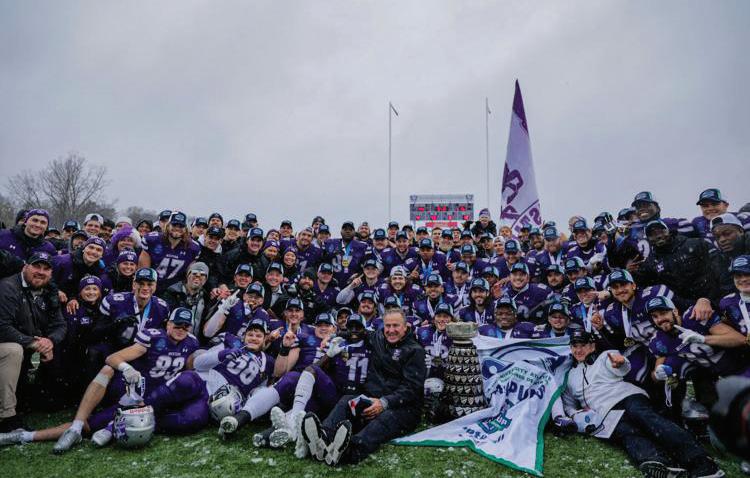
SPORTS | P7
SOPHIE BOUQUILLON GAZETTE Jordan Murphy (32) embraces Jackson Findlay (30) on the Western sideline, Nov. 12, 2022.
SOPHIE BOUQUILLON GAZETTE Keon Edwards (5) and Brayden Misseri (84) celebrate after an Edwards touchdown in the 114th Yates Cup, Nov. 12, 2022.
SOPHIE BOUQUILLON GAZETTE Western mascot J.W. does pushups during the 114th Yates Cup, Nov. 12, 2022.
SOPHIE BOUQUILLON GAZETTE
The Mustangs celebrate with the Yates Cup, Nov. 12, 2022.
‘Every loss is a lesson’: Mustangs rugby seasons end in OUA semi-finals
VARUN REDDY SPORTS INTERN

The Mustangs women’s and men’s rugby teams were defeated in the OUA semi-finals, ending their 2022 season.
The women’s season came to an end on Oct. 22, after a dramatic 89–0 shutout at the hands of the Queen’s University Golden Gaels.

Queen’s went into the matchup undefeated, and carried on to win the Ontario University Athletics championship.
“Every loss is a lesson and we now have a solid blueprint for o season planning and working towards next season,” said Western University women’s rugby head coach Josh Campbell.
The Mustangs went into the playo s with a 4–2 record on the season, sitting third in the OUA standings. Western second-year player Jenna Lawrence placed fourth in OUA scoring for women’s rugby with 61 points.
“It’s a team sport and it’s going to be a team effort to get ready for next year,” said captain Cailyn McKay, who will be returning next year.


The Mustangs men’s rugby team also fell short in the semi-finals, having their season come to an end without a championship appearance. Western faced o against the University of Guelph Gryphons at home on Nov. 9 in the OUA semi-final playo matchup.
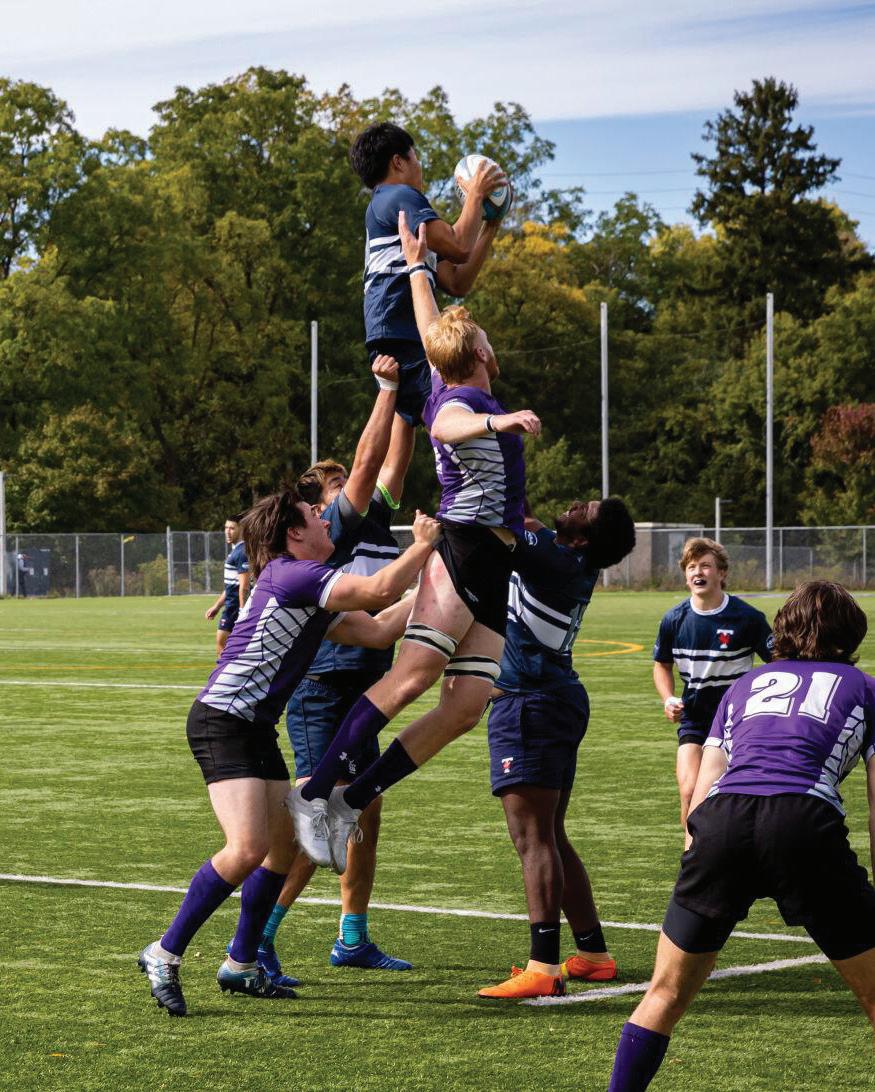
The game was quickly tied 7–7 in the first quarter but the Gryphons caught fire and finished the half at 24–12.
“Nerves showed up a little bit early,” said men’s head coach Ian McLeod. “We settled down as the game went on, but a little bit too late.”

Western attempted to overcome the reigning champion’s extended lead, but the Mustangs were two tries short. Western lost the semi-final game 36–24.


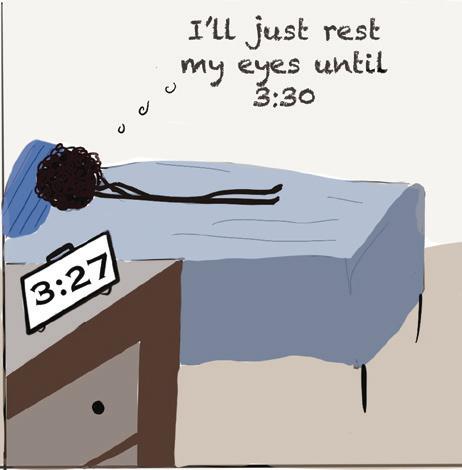

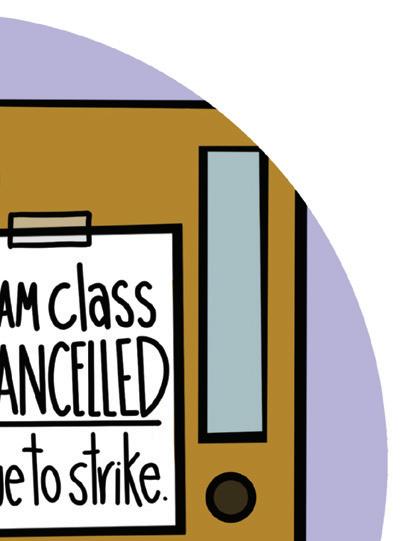



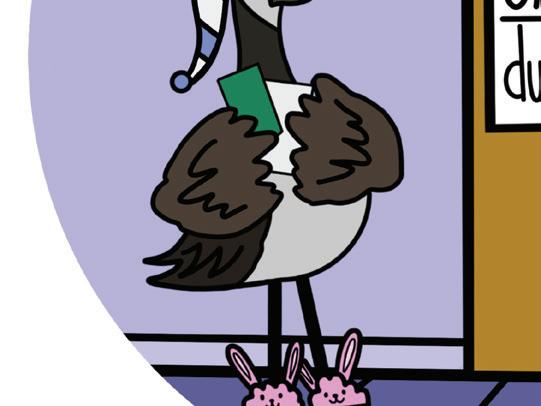
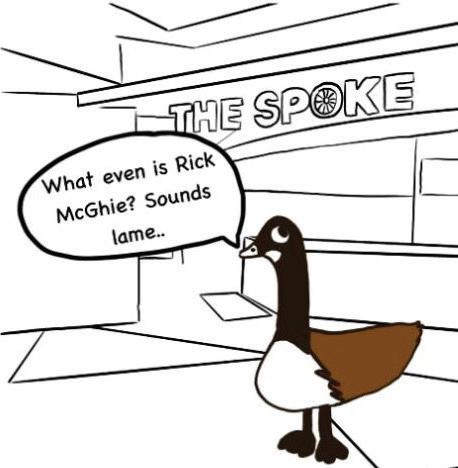
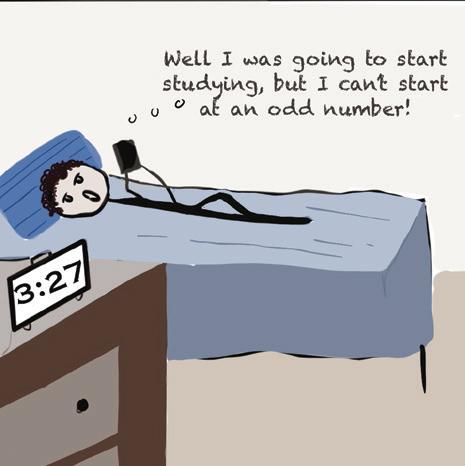


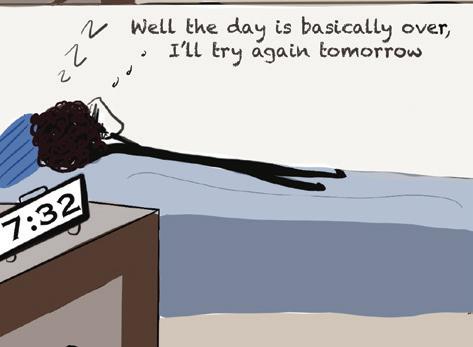
Despite the early end to the season, the Mustangs began their regular season with a promising 5–1 record.
Second-year William Matthews and third-year Joel Abdel Barr were third and seventh respectively in OUA men’s rugby scoring this year.



With the Western rugby season ending, Campbell said they’re already focusing on next year.
“The rolling stone gathers no moss,” said Campbell. “We will strive to be better every day than we were the day before.”
Mustangs football recognized with slew of individual OUA awards
KIERAN DROVER SPORTS EDITOR
The Mustangs men’s football team’s success this season has led to three team members winning major individual conference awards at the OUA’s awards ceremony Nov. 10 and 14 being named OUA all-stars.
For the eighth straight season, Mustangs head coach Greg Marshall has been recognized with the David ‘Tu y’ Knight award as Ontario University Athletics’ football coach of the year. Marshall led the team to its first undefeated season since 2019 and credited his selection to two late Western University football coaches who he once played for and coached under — Darwin Semotiuk and Larry Haylor.
“My coaches and mentors … I learned from the best,” said Marshall at the OUA awards ceremony. “I learned from Darwin Semotiuk and Larry Haylor, [and] they were the best. Not just great coaches but great people, and special friends for me.”
Part of the credit for Marshall’s recognition went out to his players — specifically, Mustangs fifthyear running back Keon Edwards, who took home OUA football’s most valuable player award, which was recently renamed the Larry Haylor Award.
The Mustangs superstar running back gained 1,032 rushing yards to go along with nine rushing touchdowns. While Edwards was honoured to have received the award, he recognized the team for his motivation and success.
“The way I do it, it’s [honestly] the team,” said Edwards. “This trophy honestly represents something we’ve all been working hard for and I just do it for them.”
Another Mustang, sixth-year free safety Daniel Valente Jr., was presented the President’s Award as the OUA’s most outstanding stand-up defensive player.
Valente Jr. finished the season with a league-leading five interceptions on top of his 16 tackles and one sack.
Marshall, Edwards and Valente Jr. led a team of 14 OUA all-stars after it was announced the Mustangs led the province in OUA all-star selections this season. Headlined by second-year quarterback Evan Hillock and sixth-year defensive tackle Malcolm Hinds, the announcement included nine Western first-team and five second-team all-star picks.
The Mustangs will continue their quest for the Vanier Cup in the MItchell bowl — the U Sports semi-final — against the Laval Rouge et Or Nov. 19 at Western Alumni Stadium. The Mustangs previously defeated the Queen's University Golden Gaels 44–16 Nov. 12 to win the 114th Yates Cup.
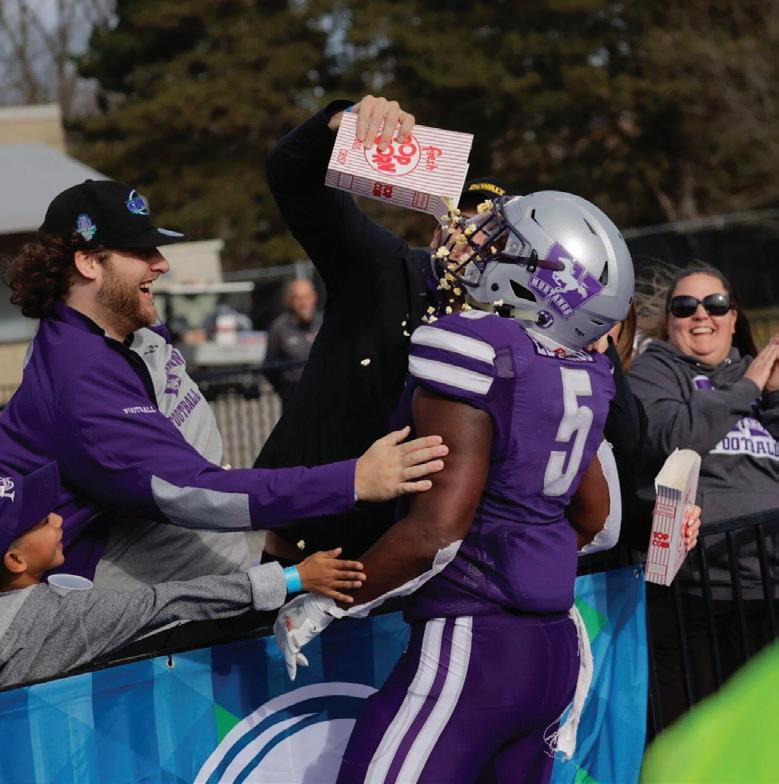
SPORTS | P8 ERIN GRACE GAZETTE
QARRI GAZETTE Email your comics to comics@westerngazette.ca or come to UCC 263 and ask about volunteering for our Graphics section! JESSICA COUNTI GAZETTE
ARISIA
RYAN GOODISON GAZETTE Keon Edwards celebrates with some popcorn after scoring a touchdown, Nov. 5, 2022.
SOPHIE BOUQUILLON GAZETTE
The Mustangs men's rugby team playing the Varsity Blues in a regular season game, Oct. 1, 2022

























 BOUQUILLON GAZETTE
BOUQUILLON GAZETTE







 CAT TANG CULTURE EDITOR
CAT TANG CULTURE EDITOR



































 LAUREN MEDEIROS CULTURE EDITOR
LAUREN MEDEIROS CULTURE EDITOR
 SAANVI KAPOOR CULTURE INTERN
SAANVI KAPOOR CULTURE INTERN
 LAUREN MEDEIROS CULTURE EDITOR
LAUREN MEDEIROS CULTURE EDITOR






























